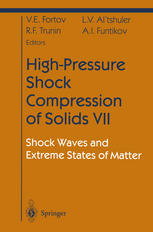

Most ebook files are in PDF format, so you can easily read them using various software such as Foxit Reader or directly on the Google Chrome browser.
Some ebook files are released by publishers in other formats such as .awz, .mobi, .epub, .fb2, etc. You may need to install specific software to read these formats on mobile/PC, such as Calibre.
Please read the tutorial at this link: https://ebookbell.com/faq
We offer FREE conversion to the popular formats you request; however, this may take some time. Therefore, right after payment, please email us, and we will try to provide the service as quickly as possible.
For some exceptional file formats or broken links (if any), please refrain from opening any disputes. Instead, email us first, and we will try to assist within a maximum of 6 hours.
EbookBell Team

4.8
84 reviewsIn the mid-1950s, experimental studies of condensed matter at ultrahigh pressures (i.e., high energy densities) started to appear in the literature, made possible by use of strong shock waves to alter the state of the material studied. Since then, laboratory and underground nuclear test results have provided equation-of-state data for many chemical elements and compounds over a very wide range of thermodynamic states. They have also allowed scientists to determine high pressure melting curves, to discover previously unknown electronic transitions, to produce strongly non-ideal plasmas, and to study phenomena that occur at much higher values of physical parameters than are attainable by other methods. The data are of fundamental scientific value, and knowledge of shock-wave properties of materials and their equations of state over a wide range of the thermodynamic variables is necessary for the solution of many important scientific and technical problems.
Shock Waves and Extreme States of Matter presents a detailed account of the development of Russian technology for conducting dynamic experiments to study material properties and behavior and some of the basic results so far obtained. The book consists of surveys prepared by the leading Russian scientists in the field. Experimental and theoretical results of the authors are presented and a generalization and systematization of the extensive material on the physics of shock waves and high-pressure phenomena is provided.
Topics discussed include:
Development of dynamic research techniques for studying high pressure
Problems of detonation of condensed explosives and creation high-velocity-impact devices
Shock compression data that reach a maximum pressure of 10 TPa in solid and highly porous metals. Computational models and descriptions of experimental data include wide-range Hugoniots for 80 substances
Mechanisms, kinetics and thermodynamics of polymorphic transformations
Experimental, theoretical, and computational investigations of the response of metals in the range of elastic–plastic deformation
Optical temperature measurements on ionic crystals and liquid argon and xenon that permit development of improved equations of state of these materials and extend the melting curves of ionic crystals
Quasi-isentropic compression data for molecular hydrogen and deuterium and the parameters of a new EOS for the solid and liquid phases
Both a semiempirical extension of van der Waals’ model oriented toward experimental data description of dense states of matter and an a priori chemical model of highly non-ideal plasma produce wide-range EOSs
Fracture of large structures subjected to the action of dynamic forces.